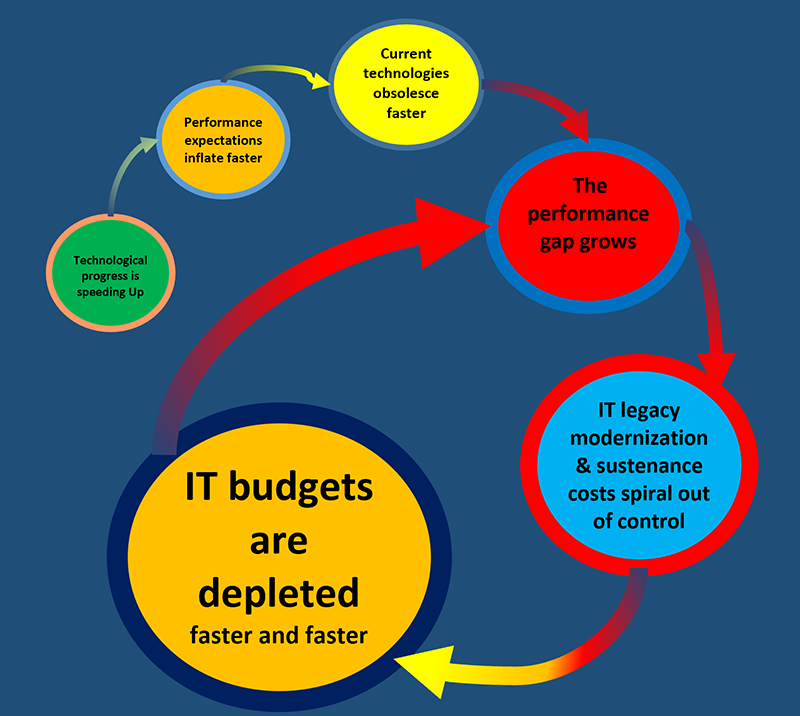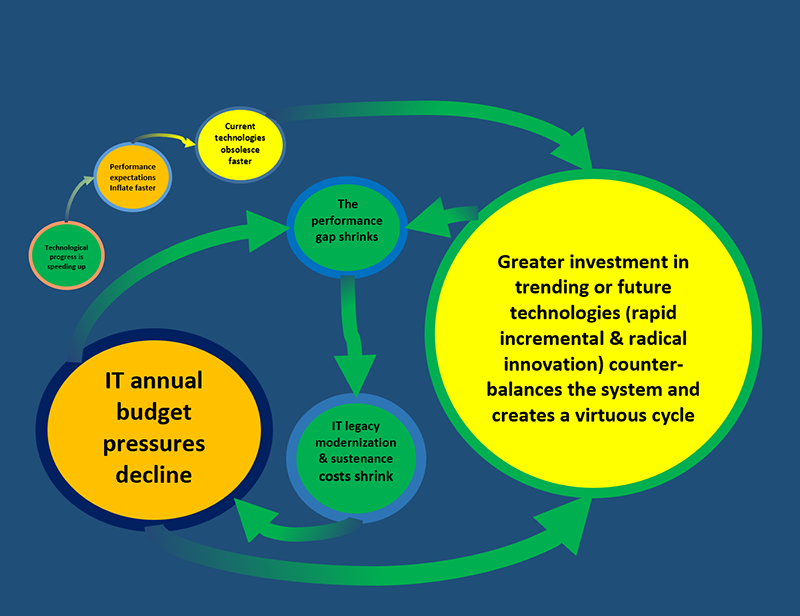Sustainable IT Modernization: Unlocking the Secret to Success

Photo credit: Pixabay
Author: Robert L. Brown
No end in sight
Have you experienced a slow sinking sensation when it comes to keeping your IT systems current, operational, and relevant? Do you feel that you are being asked to do more and more with less and less? If so, you are not alone! Despite Herculean efforts, many public sector agencies have succumbed to the continuous onslaught of change and are working hard at accomplishing more with less. It is not surprising that we’ve observed a performance slippage. As such, most agencies remain woefully short on required capability, and the need to modernize public sector IT has reached crisis levels.
Each year, public systems fall further behind modern commercial systems. Sustenance costs metastasize and eat up budgets. Agency IT capabilities slip relative to private sector standards. It’s reasonable to ask why, in 2019, this is still the case. Aren’t modern digital systems ubiquitous and easily available? Why can’t an organization just buy something off the shelf and swap out what isn’t working?
Alas, IT managers in the public space face a gnarly set of problems when it comes to investing in modern systems. But these problems are solvable if the organizations approach them differently from the way they have in the past.
The key to the approach lies in peering beyond the horizon
Like the people who work for them, organizations have operational requirements, quirks, and cultures that differ from those of other organizations, even similar ones. The same is true of reliable, off-the-shelf systems that need to be customized; and with customization comes cost and the need to forecast.
IT managers may find themselves in a vicious cycle of having to sustain their legacy systems even as their performance and utility decline (Bongiovanni, 2018; Savard, 2018) because they aren’t budgeted for modern systems. When they can embark on reform or modernization efforts—that is, they are authorized to buy what they think their organization needs—those efforts are unsuccessful or fall far short of the mark. This failure leads to ever more stressed budgets, increased maintenance demands and a host of performance challenges.
So, what is going on here that befuddles the best of us? Are there industrial or competitive realities that simply cannot be overcome? According to complexity science, the answer is a resounding “No.” This science claims that a range of uniquely powerful insights may enable a better understanding of difficult problems as well as simple strategies to address the challenges. Here we attempt to spotlight both the power and the promise of these simple strategies and lay out a path to changing the vicious cycle of IT modernization into a virtuous one.
A new pair of glasses: Shifting perspectives is a good place to start
It is first necessary to understand the primary force acting on systems today. In a very Moore’s law-driven fashion, the current pace of change (and its evil cousin: rapid obsolescence) translate into a dire and direct real-time threat to organizations, their budgets, their capabilities, and, indeed, their very survival (Reeves, 2011). This threat exists despite the fact that technological progress itself is a virtuous, or positively self-reinforcing, cycle.
Of course, systemic change, desirable or undesirable, is the result of different forces acting on a constantly evolving system. It’s like a Cold War arms race. The competitive dynamics are constantly raising the ante for survival. As the players improve, they raise the level of competition. It’s either keep up or go extinct. The key take-away from this view of reality is that the system is always in flux; it is always a balancing act among opposing or colluding forces. Understanding those forces is vital. This flux is why it is so important for modern leadership to see systems through a complex, dynamic lens—we are now in an era of constant, high-velocity, change.
If we think of all systems as systems of change, a vicious or virtuous cycle is simply the dynamic capture of systems that are either reinforcing themselves upwards, downwards, or balancing to equilibrium or mediocrity. The story of Eastman Kodak’s decline provides an excellent example. Failure to adapt and keep up with the changing times can catch up with us. In the context of all things related to modernization—whether of IT or of simply maintaining pace with customer expectations of quality and service—it is about appropriately changing or adapting faster than the demands of the surrounding reality to remain germane and avoid falling into obsolescence (Reeves, 2011). Chief amongst these adaptations is, of course, measurable and improved efficiency without which vicious cycles are bound to get worse.
Downward spirals: Seeing the forest for the trees
How does this dynamic lens help us turn a vicious cycle into a virtuous one when it comes to IT modernization? Let’s peer into this dynamic system and see if we can’t discern the forest from the trees.
In the Vicious Cycle causal loop in Figure 1, the march of technological advancement presents continuous pressures for organizational change/innovation/adaptation. In the chain of influence, each factor creates an expansion of each subsequent factor. It begins with technological progress, which inflates customer expectations and raises standards. Rising performance standards increase the obsolescence rate and reduce the useful lifespan of technology. Without new, active, and ongoing technology adoption that increases efficiency, budgets for sustenance (O&M) grow; over-all IT budgets inflate; and mission performance inevitably declines – faster and faster as each year passes. Note how the forces at play continue expanding and forcing the system into a downward spiral.

Figure 1: IT Modernization as a Vicious Cycle
This vicious cycle stems from the fact that, to keep performance from declining within legacy-dominated systems, more and more resources tend to be fed into sustenance activities, thus depriving the overarching IT budgets of necessary resources for investment into more efficient, higher ROI, modern technologies (Bongiovanni, 2018; Savard, 2018). Like trees growing too closely together in a forest, they expend too many resources competing for limited sunlight and eventually become brittle and weak. Breaking this vicious cycle is paramount. But how?
For every action there is an equal and opposite reaction
Enter the science of complexity. Complexity science proposes that looking at reality through a dynamic lens offers solutions not available to a static (assumption of no change) perspective (Sheard, 2014; Van der Steen, et al., 2013). To solve the IT modernization dilemma, managers must not only abandon static planning, but they must also be actively planning for changes expected far beyond the current future horizon. Such planning means that “this year’s modernization” must be seen within the context of an ongoing series of unending modernizations rather than a static one-time fix—a fix that only addresses today’s perceived problems. Each currently planned set of modernizations must enhance, enable, and support every successive modernization to achieve a sustained, positive, momentum—a momentum extending ad infinitum into the future. In complexity science, this way of thinking is called super-additivity or the law of increasing returns.
Let’s think about how this super additivity works. Assuming fixed, inflation-adjusted, annual IT budgets, every dollar invested in legacy sustainment is a dollar not available for improved technology. Imagine maintaining an older automobile. Each year it costs more to maintain. Each year you have less money to invest in a new, more efficient car. It’s a vicious cycle.
Conversely, according to the Three Horizons Approach (Innov8ers, 2016), by regularly investing in the new—with increased efficiencies—ever more capability is achieved at lower costs. This approach has the effect of reducing the efficiency drain, neutralizing budget inflation and mitigating the performance gap. The Virtuous Cycle in Figure 2 illustrates this approach.

Figure 2: Achieving Virtuosity by Weighting the Future Heavily
A modernization plan with a horizon 20-30 years into the future
To achieve sustainably virtuous cycles, today’s modernization plans must have these virtuous attributes as their core features. Failure to modernize our planning methods right now is likely to translate into a long-term future of stranded assets, diminishing returns, and persistently declining performance—a reality that too many IT managers are familiar with (Bongiovanni, 2018). Conversely, by thinking dynamically and weighting the future heavily, we can break the cycle and create a virtuous and sustainable path to success now and in the future.
References
Bongiovanni, Nat (2018). Strategy and Tactics for Federal IT Modernization. Retrieved 20 February 2019: https://us.nttdata.com/en/-/media/assets/white-paper/apps-mod-public-fed-it-modernization-whitepaper.pdf
Innov8ers (2016). Why big companies are losing when it comes to disruptive innovation (and how to get back on track). Retrieved 20 February 2019: https://innov8rs.co/news/win-using-disruptive-innovation/
Reeves, M., et al. (2011). Adaptability: The New Competitive Advantage. Retrieved 4 March 2019: https://hbr.org/2011/07/adaptability-the-new-competitive-advantage
Savard, P. (2018). Balancing Between a Focus on Innovation Versus Sustainment. Retrieved 20 February 2019: https://www.institutefordigitaltransformation.org/innovation-vs-sustainment/
Sheard, S., et al. (2014). Dynamics of Software Sustainment. Journal of Aerospace Information Systems 2014 11(10), 691-701
Stinebrickner, T, et al. (2007) The Causal Effect of Studying on Academic Performance. Bureau of Economic Research, Cambridge, Massachusetts, Working Paper. Retrieved 1 Feb 2007: http://www.nber.org/papers/w13341.pdf
Van der Steen, M., et al. (2013, October). Complex Causality in Improving Underperforming Schools: A Complex Adaptive Systems Approach 41(4), pp. 551-567. Retrieved 1 Feb 2017: http://www.ingentaconnect.com/content/tpp/pap/2013/00000041/00000004/art00007, Policy & Politics
Robert Brown is a Computational Modeling & Simulation Engineer at the MITRE Corporation who loves the emergent beauty of complex systems, paddle-boarding, and solving truly wicked problems. He works with government agencies on topics in Complexity Science, Innovation, and Performance. His background includes multidisciplinary PhD studies in Global Strategic Management, Complexity Science, and Innovation Management from Portland State University.
© 2019 The MITRE Corporation. All rights reserved. Approved for public release. Distribution unlimited. Case number 19-0857
MITRE’s mission-driven team is dedicated to solving problems for a safer world. Learn more about MITRE.
